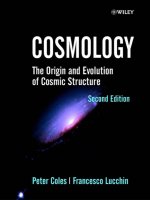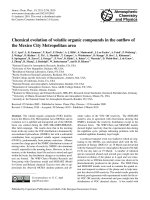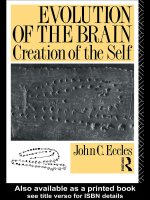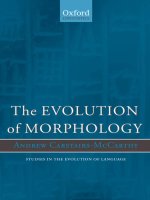eccles - evolution of the brain - creation of the self (routledge, 1986)
Bạn đang xem bản rút gọn của tài liệu. Xem và tải ngay bản đầy đủ của tài liệu tại đây (5.27 MB, 310 trang )
Evolution of the Brain: Creation of
the Self
Evolution of the Brain:
Creation of the Self
John C.Eccles
CH 6646 Contra (TI), Switzerland (all
correspondence)
Max-Planck-Institut für
biophysikalische Chemie,
D-3400 Göttingen, Germany
London and New York
First published in 1989
First published in paperback in 1991
by Routledge
11 New Fetter Lane, London EC4P 4EE
29 West 35th Street, New York, NY 10001
This edition published in the Taylor & Francis e-Library, 2005.
“To purchase your own copy of this or any of Taylor & Francis or Routledge’s
collection of thousands of eBooks please go to www.eBookstore.tandf.co.uk.”
Reprinted 1991, 1993, 1995, 1996
© 1989 John C.Eccles
All rights reserved. No part of this book may be reprinted or reproduced
or utilized in any form or by any electronic, mechanical, or other means,
now known or hereafter invented, including photocopying and recording,
or in any information storage or retrieval system, without permission in
writing from the publishers.
British Library Cataloguing in Publication Data
A catalogue record for this book is available from the British Library
Library of Congress Cataloguing in Publication Data
A catalogue record for this book is available from the Library of Congress
ISBN 0-203-97666-5 Master e-book ISBN
ISBN 0-415-03224-5 (Print Edition)
Contents
Foreword ix
Preface x
Acknowledgements xiii
List of abbreviations xiv
1 Biological evolution 1
1.1 The genetic code 1
1.2 The modern synthesis: phyletic gradualism 5
1.3 Punctuated equilibrium 7
1.4 Genetic mechanisms in hominid evolution 9
1.5 General conclusions on the evolutionary origin of
species
10
2 The general story of human evolution 12
2.1 The hominid ancestry 12
2.2 The Australopithecines 15
2.3 Homo habilis 21
2.4 Homo erectus 24
2.5 The Neandertals 26
2.6 Homo sapiens sapiens 28
2.7 Problems of hominid evolution 36
3 Evolution of hominid brain: bipedality; agility 39
3.1 The essential structural features 39
3.2 The functional performance of the brain 43
3.3 Erect standing, walking, and reacting 48
3.4 Neuronal mechanisms evolved for the fine control of
movement
63
3.5 Skilled hand movement 69
4 Linguistic communication in hominid evolution 73
4.1 The levels of language 73
4.2 Linguistic expression 74
4.3 The learning of a human language 75
4.4 The language training of apes 78
4.5 The anatomy of the cerebral cortex with special
reference to the centres for speech
83
4.6 Auditory pathways 90
4.7 The evolution of the brain in relation to the
development of speech
91
4.8 The evolution of speech production 96
4.9 Language and evolutionary survival 98
5 Cerebral limbic system in relation to the evolution
of the reproductive and emotional systems
100
5.1 Some anatomical considerations 101
5.2 Limbic system and emotional expression 103
5.3 Pharmacology of limbic system and hypothalamus 106
5.4 Size indices of components of the limbic system during
primate evolution
108
5.5 Consequences of the brain enlargement in hominid
evolution
109
5.6 The demographic strategy of hominids 111
5.7 The evolution of altruism 117
6 Visuo-motor evolution: artistic creativity 121
6.1 The visual areas of the primate cerebral cortex 121
6.2 Neuronal responses in the primary visual cortex 122
6.3 Stereopsis 125
6.4 The prestriatal visual areas 127
6.5 Lesions of the striatal and prestriatal visual areas 131
6.6 Investigations on human brains in visual responses 132
6.7 Conclusions on visual evolution 136
6.8 The evolution of stone culture 138
6.9 The engraving of bone plaques 139
v
6.
10
The visuo-constructive cerebral areas 142
6.
11
Creativity in the plastic arts 143
7 Evolution of learning and memory 146
7.1 Anthropoid apes as a model for the ancestral hominoid 146
7.2 The learning of symbols for communication 149
7.3 Comparison of ape learning with human learning 150
7.4 Sizes of brain regions related to memory 152
7.5 The neuroscience of learning and memory 154
7.6 Some special features of human memory 174
7.7 Conclusions 178
8 The mind-brain problem in evolution 179
8.1 Historical introduction 179
8.2 Consciousness of non-human animals 180
8.3 The evolution of consciousness 181
8.4 Philosophy of the mind-brain problem 184
8.5 Experimental testing of the mind-brain problem 186
8.6 Neuronal structures concerned in mind-brain
interaction
191
8.7 Diagrammatic comparison of mind-brain theories 194
8.8 A new hypothesis of mind-brain interaction based on
quantum physics—the microsite hypothesis
195
8.9 Reconsideration of the mind-brain problem 200
9 The self and its brain 203
9.1 Anatomically observed asymmetries 203
9.2 Functional asymmetries 204
9.3 The modular design of the cerebral neocortex 210
9.4 The evolutionary pinnacle: the dawn of
selfconsciousness
211
9.5 The unity of the self 213
9.6 Commissurotomy 215
9.7 The evolutionary significance of the cerebral
asymmetry
220
vi
9.8 Developmental and structural indications of neocortex
having a late evolutionary origin and a late
ontogenesis: the neo-neocortex
221
10 The human person 227
10.
1
The human person 228
10.
2
Cultural evolution 229
10.
3
Biological and cultural evolution 232
10.
4
The concept of mind 236
10.
5
Specific human characteristics 239
10.
6
Evolution of human nature 246
10.
7
The creation of the self or the soul 247
Addendum: reflections and imaginings 251
References 259
Subject index and glossary 281
vii
To Helena who created beauty in life
Foreword by Sir Karl Popper
I regard this book as unique. The problem of the descent of man
has been discussed intensely since Darwin’s Descent of Man
(1871), but never before has a brain scientist collected all the
evidence (and there is a lot of it) pertaining to the most important
of all the big problems—the evolution of the human brain, and of
the human mind.
The book is a synthesis of comparative anatomy—especially
brain anatomy—of the evidence of palaeontology and archaeology
(which have here been brought together as rarely before), of brain
physiology and especially the physiology of language, and of
philosophy; all set into a framework of Darwinian evolutionary
theory, and making allowance for the latest critical developments
of Darwinism. The result is a detailed Panorama—a picture not
attempted by anybody before.
It is an extraordinary achievement and an excellent book.
February 1988
Preface
It is extraordinary that there has been so little publication on the
brain developments during the most important creative process of
biological evolution, namely from our hominoid ancestors through
some 9 to 10 million years of hominid evolution to the human
brain with its transcendent capacity for creativity. The story of
hominid evolution to Homo sapiens sapiens is the most wonderful
story that can be told. It is our story. Each of us has to realize
that the great success of hominid evolution was the only chance
of existence as human beings, if one dares to speak
retrospectively. Why then is this story not being often told in the
essential features of the coming-to-be of human brains, as has
been done in this book? It could be that the brain evolution story
appears to be empty of facts and good only for unjustified
speculations. While recognizing that much is unknown or only
imperfectly known, I have been able to unfold the fascinating story
of hominid evolution of the human brain using creative
imagination restrained by rational criticism.
At a time when it is fashionable in certain quarters to denigrate
Darwinism and even rationality, this book conforms with the
Darwinist hypothesis of biological evolution except that phyletic
gradualism gives place at intervals to such modifications as the
punctuated equilibrium (Section 1.3) and possible chromosomal
rearrangements (Section 1.4). The theme of the book goes beyond
the materialistic concepts of Darwinism only in the last three
chapters, where there is consideration of the most controversial
evolutionary happenings. First, there was the emergence of
consciousness in the higher animals (Chapter 8) and secondly the
much more remarkable transcendence when hominids
experienced self-consciousness (Chapters 9 and 10).
Right at the outset of hominid evolution there is mystery. As
revealed by albumen dating, the hominoid line split into hominid
and pongid evolutionary lines at 9 to 10 million years ago
(Section 2.1, Table 2.1). Unfortunately there is an almost complete
fossil ‘black-out’ for 5 million years after this most critical time of
hominid evolution (Sections 2.1 and 2.2). Presumably the number
of hominids was then extremely small. During those 5 million
years there was the evolutionary transformation to bipedal
walking as told in Section 3.3. One can assume that there were
series of stages between the arboreal hominoids and the
terrestrial Australopithecines. When the ‘curtain lifted’ 4 million
years ago (Section 2.2), the fossil record of a bone and muscle
system almost fully transformed for bipedality was disclosed
(Figures 3.8, 3.9, and 3.10). Surprisingly there was only a small
increase in brain size (Figures 2.4 and 2.6). Yet in the shift from
quadrupedality to bipedality there must have been a
transformation of the neural machinery of the brain to give the
fully evolved bipedal walking that is exhibited in the most
wonderful of all fossils, the Laetoli footprints (Figure 3.11).
In the last few decades there have been very rich discoveries of
fossil hominids from 4 million years ago to recent times, as briefly
told in Chapters 2 and 3. Even the transformation of the brain can
be recognized in the endocasts (Figures 2.7 and 2.9). In
attempting to appreciate the changes wrought by hominid
evolution, it is necessary to utilize a modern pongid brain as a
model for the ancestral hominoid brain. The attempt to portray
the cerebral changes in hominid evolution has been greatly helped
by the exquisite studies of Heinz Stephan and his associates. They
have measured the sizes of anatomically identified cerebral
structures such as nuclei in a wide variety of primate brains
including human brains. The calculated size indices are the basis
of many tables in the book.
It must be recognized that only from the higher primates could
there have been the evolutionary process leading to beings with
the finesse of human perceptual and motor systems. Human
evolution was built upon the evolution already accomplished by
the higher primates, and so particularly by the hominoids. An
excellent example is provided by their superb visual system
(Chapter 6) with eyes perfectly adapted for binocular vision. The
visual pathways project to the primary visual cortex and thence to
the prestriate cortex in a manner that was not appreciably
changed in evolution to Homo sapiens. Of supreme importance is
the cerebral cortex, which in the upper primates is the nearest to
the human cerebral cortex (Chapters 8 and 9). Also of importance
is the limbic system (Chapter 5) and the learning systems
(Chapter 7), which are very similar to the human in general design.
With the cerebral cortex new areas evolved to give the most
important functions of the human brain, in particular the speech
areas (Chapter 4) that at the most were rudimentary in the pongid
brain and non-existent in other primates. As discussed in
Chapter 9, these new areas are functionally asymmetrical. Not
only were they the last to evolve, but they also are the last to come
into function in ontogenesis. In Chapters 9 and 10 there will be
special concentration on this distinctively human cortex, which is
called the neoneocortex with its gnostic functions.
In primate evolution there was what we might call conservative
wisdom. It can be expressed by an evolutionary adage: never trade
a basic inherited feature for seemingly attractive short-term gains,
xi
for example the five freely moving digits of the limb for a paw or a
hoof or a wing. So hominid evolution took off with the conserved
early vertebrate limb with digits and was able to transform them
into the invaluable hand and foot (Sections 3.3–3.5). The hand in
particular gave the hominids pre-eminence in evolution, and
consequently was continuously perfected, with of course the
neural machinery (Section 3.5).
The question is often asked: is our evolutionary line the only one
that could conceivably lead to beings with intelligence and
imagination matching or even transcending ours? Could for
example some super-intelligent apes initiate another evolutionary
line matching and even surpassing the hominid line? The answer
must be no! Hominid evolution depended on the quantal advances
by very small isolates separated from the main genetic pool.
Moreover, an immensely long isolation time would be required for
each new species—hundreds of thousands of years. Such
conditions can never be reenacted on Planet Earth with its
dominance by communication systems and operators! In fact,
even in the past, hominid evolution happened only once, and then
for millions of years it depended on a minute population with
complete extinction as an ever-present danger.
So the story of hominid evolution on Planet Earth that I tell in
this book is unique and never to be repeated. Homo sapiens
sapiens need not fear upstart rivals!
This book has concentrated on the evolution of the human brain
with the coming to be of consciousness and self-consciousness. It
is recognized that there can be no physicalist explanation of this
mysterious emergence of consciousness and self-consciousness in
a hitherto mindless world. The philosophical consideration of this
problem in Chapters 8, 9, and 10 leads in Chapter 10 to a
religious concept of the coming-to-be of the self-consciousness
that each of us experiences. It is proposed that at the core of our
mental world, the World 2 of Popper (Figures 9.5 and 10.4), there
is a divinely created soul. This theme is further developed in the
latter part of the Addendum.
xii
Acknowledgements
I wish to express my thanks to the Neuroscience Institute, New
York and to Professor G.Edelman and Dr Einar Gall and staff for
their invaluable help in making the writing of this book possible.
My wife and I spent two three-month periods at the Institute.
Professors W.Singer and M.Klee greatly helped in arranging for the
preparation of the illustrations by Ms Hedwig Thomas and
assistants. Drs Patrick and Edie McGeer most generously made
possible a visit to their Institute in Vancouver, where the whole
text was put onto their word processor. Professor P.V.Tobias
provided me with wise advice and criticism on the evolutionary
section of the book, and I am grateful also for the comments of
Professors Hans Freund and Gunther Baumgartner on the
chapters I submitted to them.
I leave to the end a special tribute to my wife, Dr Helena Eccles,
who has been deeply immersed in all aspects of the creation of
this book—in typing and retyping the whole text and in her wise
critical judgements.
A book of this nature is dependent on good illustrations, and I
am grateful to the publishers and scholars who generously
granted permission for publishing their figures and tables:
Publishers: Academic Press, Alan R.Liss, Elsevier Science
Publishers, Annual Review, Pontificiae Academiae Scientiarum,
John Wiley & Sons, MIT Press, Raven Press, Plenum Press, The
Royal Society, S.Karger, A.G., Springer-Verlag, Oxford University
Press, J.Physiology, Weidenfeld & Nicolson Ltd, Science. Other
publishers are listed under the figures as requested.
Authors: H.Stephan, A.Marshack, S.L.Washburn, C.D.Lovejoy,
M.H.Day, C.Brinkman, R.Porter, L.G.Ungeleider, E.G.Jones, P.V.
Tobias, G.Ledyard Stebbins, R.L.Holloway, V.B.Brooks, P.Roland,
R. Sperry, D.Premack, S.J.Gould, J.F.Iles, D.W.Pfaff, E.Mayr, D.H.
Hubel, K.Sasaki, K.Akert, M.Ito, J.Szentágothai, M.Sakurai,
H.Freund, D.Marsden, L.M.Nashner, M.D.Leakey, D.Kimura,
H.H.Kornhuber, R.B.Kelly, A.Walker, P.Rakic, E.Trinkaus,
E.L.Simons, P.Handler, G.G.Simpson.
List of abbreviations
ASL American Sign Language
BoW body weight
BP before present
BrW brain weight
byBP billion years before present
CBL cortico-basolateral group of amygdala nuclei
CM centromedial group of nuclei
CNV contingent negative variation
DNA deoxyribonucleic acid
EI encephalization index
EMG electromyogram
FPSP excitatory postsynaptic potential
EQ encephalization quotient
FSH follicular stimulating hormone
FSR functional stretch reflex
HSN Homo sapiens neanderthalis
HSS Homo sapiens sapiens
LGB lateral geniculate body
LLR long-loop reflex
LTD long-term depression
LTM long-term memory
LTP long-term potentiation
MI primary motor cortex
myBP million years before present
Nnewton
NMDA N-methyl-D-aspartate
PM premotor cortex
rCBF regional cerebral brain flow
RNA ribonucleic acid
SI size index
SMA supplementary motor area
STM short-term memory
STS superior temporal sulcus
yBP years before present
xv
Chapter one
Biological evolution
1.1
The genetic code
In order to be able to present an intelligible story of the essentials
of the evolutionary process, it is necessary first to give a much-
simplified account of the genetic material of the cell,
deoxyribonucleic acid (DNA), and of the mode of its action via the
genetic code. The segregation of this essential evolutionary
material into the cell nuclei was achieved very early in the
evolution of the unicellular eukaryotes that arose about 1.8 billion
years ago. This was a very important evolutionary development
because it protected the complex machinery that is central to all
cell activity including reproduction.
The DNA of the nucleus is a densely coiled and extremely long
double helix. As diagrammed in Figure 1.1, each strand is
constructed of alternate phosphate (P) and sugar (ribose) moieties.
To each sugar there is attached one of the following four
molecules: the purine bases, adenine (A) and guanine (G), and the
pyrimidines, thymine (T) and cytosine (C). The two helices are
effectively cross-linked every 3.4 Å (Figure 1.1). A in one links to T
in the other or G in one to C of the other. So a sequence could be:
GTAGCAT
CATCGTA
for the linkage pairs of a very short segment of the two helices.
The nucleotide code is thus written linearly along each strand.
Figure 1.2a shows the atomic structure of the double helix with
below the phosphate (P) and sugar (S) chain and the cross-linkage
by the purine and pyrimidine bases through the hydrogen bonding
of A with T and C with G. Figure 1.2b illustrates the manner in
which the linear code of the DNA is translated to messenger RNA
(ribonucleic acid), which effects the segmental building of the
amino acid sequences of a protein by means of a three-letter code
acting like a machine language in specifying the sequence of the
five amino acids in this specimen record.
For a bacterium the code of each strand has about 1.5 million
letters. With Homo there are about 3.5 billion letters in each DNA
strand, which gives the preliminary information for building all of
the cells of a human being. Before the cell divides, the two
strands of the double helix separate and an enzyme system makes
for each the complementary strand. The two double helices that
are thus reconstituted are almost always identical copies of the
original. The genetic information that builds and controls the cell
is coded in the nucleotide sequences, the ATGC letters, along the
DNA strands.
It is beyond the scope of this chapter to go into the detailed
manner in which, by the precise processes of transcription and
translation, this DNA code is read out in the building of the amino
acid sequences of a protein (see Figure 1.2b), and so is effective in
building the structure of the cell and in the enzymatically
controlled metabolism of the cell. Enzymes are proteins. The code
for any such action in building a protein is carried in linear array
on the DNA strands, not by a short sequence of letters as
illustrated above, but by some thousands of letter sequences,
called a gene. Genes carry the precise instructions for building the
amino acid sequences of particular proteins. It will be recognized
that, for building the many species of proteins required for the
living processes of a bacterial cell, its DNA chain of about 3 million
letter sequences is not extravagant. With our cells the number is
more than 1,000 times greater, 3.5 billion. This seems rather
extravagant for coding the information required to build the
proteins of our cells. It has been estimated by Dobzhansky
(personal communication) that the number of human genes is at
least 30,000. For an average protein of 500 amino acid sequences,
1,500 nucleotide pairs are required, because three pairs are
required for each sequence. So 30,000 genes require 4.5×10
7
nucleotide pairs. However, with redundancies the number could
be many times larger, so lifting this low ratio of 1.4 per cent.
Moreover there is the unsolved problem of the ‘silence’ of at
least 30–70 per cent of the mammalian genome. A partial solution
is in the DNA spacers, which are sequences separating the active
DNA segments.
Normally in reproduction there is an accurate copying of the
linear code written in the DNA, and hence there is stability in the
genes from generation to generation. However, changes called
gene mutations do occur in the DNA code. There may be mistakes
in copying with the replacement of one nucleotide for another,
such as G for A, or there may be more radical changes with
deletion or inversion of one or more nucleotide base pairs or even
inversion of larger DNA segments. These copying errors may lead
to the substitution of one amino acid for another in a protein. The
effect of this may be negligible in the functioning of the protein.
However, in the great majority these exchanges are deleterious to
the survival and reproduction of the individual, which
consequently is eliminated in the process of natural selection.
2 EVOLUTION OF THE BRAIN: CREATION OF THE SELF
Only on rare occasions is a mutation beneficial for survival and
Figure 1.1 The double-stranded helical configuration of the DNA
molecule. The two nucleotide strands are held together by hydrogen
bonds forming between the complementary purine (A or G) and
pyrimidine (T or C) pairs. Note the dimensions given for the spacing, and
for width and length of one helical configuration.
BIOLOGICAL EVOLUTION 3
reproduction. Such a mutation will be transmitted to successive
generations and will result in enhanced survival of the biological
group sharing this mutation. So after many generations by
natural selection this favourable mutation may come to be
incorporated in all members of that species, which consequently
reflect a slight change in genotype. Later another mutational
selection may be added, and so on.
This is the essential basis of the modern version of Darwin’s
theory of natural selection or survival of the fittest. Favourable gene
mutations are selected, whereas the unfavourable are eliminated.
Figure 1.2 (a) Above: atomic structure of DNA molecule. Below: diagram
of connections in DNA-S, sugar, P, phosphate, covalent bonds as lines,
hydrogen bonds as dots. (b) Diagram of a small segment of DNA with the
processes of transcription to RNA and translation from RNA to amino
acids. From Darwin to DNA, Molecules to Humanity by G.Ledyard Stebbins
Copyright © WH Freeman and Co. Reprinted with permission.
4 EVOLUTION OF THE BRAIN: CREATION OF THE SELF
Hence by an initial process of pure chance, the gene mutation,
there can be wrought by natural selection all the marvellous
structural and functional features of living organisms with their
amazing adaptiveness and inventiveness. As so formulated, the
evolutionary theory is purely a biological process involving
mechanisms of operations that are now well understood in
principle, and it has deservedly won acceptance as providing a
satisfactory explanation of the development of all living forms from
some single extremely simple primordial form of life. This theory,
stemming from Darwin and Wallace, must rank as one of the
grandest conceptual achievements of man. Yet it is in need of
remodelling (Sections 1.2 and 1.3 below).
A recent development has been the recognition that many
mistakes in DNA copying are virtually neutral. For example, the
mutation may result in a changed amino acid sequence in a part
of the protein that is not vital for its functioning. Or, again, the
mutation may be in a part of the DNA that is not concerned in
building protein, so it will be selectively neutral. In time there can
be a large accumulation of such neutral mutations that have
changed considerably the original DNA of a population. With a
changed environment these mutations may no longer be neutral.
The DNA of a cell nucleus does not exist as an enormously long
double helix of about 2 m in length, but is subdivided into
segments that compose the chromosomes, which become evident
when the cell is in the process of meiosis during subdivision. Then
the human genome is seen to be packaged into 23 pairs of
chromosomes each with its distinctive character (Figure 1.3). In
meiosis the chromosomes with their contained DNA subdivide and
separate to form the sex cells, and, when there is fertilization, the
full complement of DNA is reconstituted, half coming from each
sex cell.
The four living species of Hominoidea (Table 2.1) are very similar
in their nuclear structure. The three species of pongids—
chimpanzees, gorilla, and orang-utan—have 48 chromosomes. In
Homo two pairs of chromosomes have united by centric fusion to
form chromosome 2, hence Homo has 46 chromosomes
(Figure 1.3). In other respects there is a remarkable similarity,
even to the details of the banding patterns along the chromosomes
of the respective species.
1.2
The modern synthesis: phyletic gradualism
(Mayr, 1963)
Ever since Darwin it has been recognized that biological species
play the key role as units in evolution. A species consists of a
population rather than of unconnected individuals. The
population of a species is reproductively isolated from all other
species because of the fertility criterion. Other rather similar
species may inhabit the same territory, but despite this sympatric
BIOLOGICAL EVOLUTION 5
coexistence there is no interbreeding. ‘Each’ species is a delicately
integrated genetic system that has been selected through many
generations to fit into a definite niche in its environment’ (Mayr,
1963:109).
In the Darwinian perspective palaeontology accounted for the
formation of new species by transformation of the ancestral
population by a very slow process with large numbers of
individuals in the inhabited territory. It is a process that Eldredge
and Gould (1972) called phyletic gradualism. Unfortunately this
gradualness is not shown in the fossil record. The
classical evolutionists attribute this deficiency to the imperfection
of the fossil record. The fossils indicate a story of sharp breaks or
saltations in the evolutionary process. The genetic diversity of a
species is due to mutations, recombinations, deletions, etc. in the
genetic transmission from one generation to the next. However, it
Figure 1.3 A photograph of a normal complement of chromosomes of a
human female enlarged 15,000 times. The normal number of
chromosomes in the human is 46. (Handler, 1968.)
6 EVOLUTION OF THE BRAIN: CREATION OF THE SELF
is controlled by the collective process of gene flow in the
successive generations of a freely breeding population.
Nevertheless, no two individuals of a sexually reproducing
population are genetically identical (Mayr, 1963), except for
identical twins.
Despite the homogenizing effect of gene flow, the modern
synthetic theory of phyletic gradualism ‘continued this tradition of
extrapolation from local populations and used the accepted model
for adaptive geographical variation —gradual allelic substitution
directed by natural selection—as a paradigm for the origin of
species’ (Gould, 1982:134; ‘alleles’ is used here as a
collective name for genes). This global concept has been called
sympatric continuity. However, Mayr (1963) recognized that
speciation could occur more rapidly and effectively in small
isolated populations. A small founding population would migrate
so that it is isolated from the gene flow of the large ancestral
population. But this model adhered to the principle of phyletic
gradualism in the peripheral isolate. The successful speciation
occurred because of the cumulative effects of small adaptive
variations through a large number of generations. The advantage
of the isolate was solely due to the diminished homogenizing effect
of the gene flow within the small population.
1.3
Punctuated equilibrium
Eldredge and Gould developed a theory of allopatric speciation in
which a new species can arise
only when a small local population becomes isolated at the
margin of the geographic range of its parent species. Such
local populations are termed peripheral isolates. A peripheral
isolate develops into a new species if isolating mechanisms
evolve that will prevent the re-initiation of gene flow if the new
form re-encounters its ancestors at some future time. As a
consequence of the allopatric theory, new fossil species do
not originate in the place where their ancestors lived. (1972:
94)
Eldredge and Gould (1972) postulate that the development of a
new species in the peripheral isolate occurs in a short period of
time relative to the duration of the species, and, if there is
migration back to the territory of the ancestral species, the two
species will coexist sympatrically without interbreeding. This can
be observed in the fossil record. Thus long periods of stasis are
punctuated by episodic events of allopatric speciation. This is the
hypothesis of punctuated equilibria.
As mentioned above, phyletic gradualism depends on unitary
gene mutations, which, if adaptive and successive, are gradually
BIOLOGICAL EVOLUTION 7
accumulated by selection over long periods of time. There are now
alternative models that give fast punctuational effects. Major
chromosomal changes may give the genetic changes requisite for
speciation in a few generations of a peripheral isolate. Thus
speciation may be dependent on gene regulation and
rearrangement rather than on the classical point mutations that
produce new genes in phyletic gradualism. Also large phenotypic
changes may result from changes in the timing of regulatory
genes, which in this way would cause the production of a new
species (Bush et al., 1977). Carson proposed that:
speciational events may be set in motion and important
genetic saltations towards species formation accomplished by
a series of catastrophic, stochastic genetic events…initiated
when an unusual forced reorganization of the epistatic
supergenes of the closed variability system occurs … I
propose that this cycle of disorganization and reorganization
be viewed as the essence of the speciation process. (1975:88)
This proposed saltatory origin of species is not adaptive as is the
case in classical phyletic gradualism with selection as the key
control of the random point mutations. Reproductive isolation
with the large fast saltatory genetic changes comes first and is not
adaptive. Gould (1982) goes so far as to argue that, though the
saltatory formation of species provides the raw material for
selection, there is a diametric difference between these two
alternative theories of speciation. According to phyletic
gradualism, point mutations lead to allelic substitutions in local
populations that are sequential, slow and adaptive by selection.
According to the punctuational equilibrium hypothesis, the
saltatory origin of new species is discontinuous and nonadapting
and is only secondarily subject to selection.
There may be saltatory production of an extreme character
producing what is ironically termed a hopeful monster. Selection
may determine whether or not a ‘hopeful monster’ survives, but
the primary constraint upon its genesis and direction resides with
the inherited ontogeny, not with selective modelling (Gould, 1982:
142).
The fertility criterion for a new species is important in
attempting to understand the evolutionary processes of hominids.
For example, when a peripheral isolate has evolved to form a new
species, it can migrate back to the ancestral population and retain
its identity despite the pervasive gene flow. This flow is ineffective
because of the sterility between species. A familiar example is the
horse and the donkey. The genetic constitutions of these two
species are so close that donkey sperm can fertilize a horse ovum
to give a hybrid, a mule. The mixed genetic constitution is very
effective onto-genetically to build a strong animal, but mules are
sterile. In the reproductive process the split DNA strands cannot
effectively come together because of differences, particularly with
8 EVOLUTION OF THE BRAIN: CREATION OF THE SELF
spacer DNA between genes. In the male hybrid the reproductive
cells have highly abnormal gene combinations and so are non-
functional (Stebbins, 1982).
1.4
Genetic mechanisms in hominid evolution
(White, 1978)
These theoretical considerations of the genetic mechanisms of
evolutionary change will be of great value when we come in later
chapters to a study of hominid evolution that is based on the
fossil record. Some of the key happenings in hominid evolution
seem to occur without leaving a fossil trace. For example, in
hominid evolution the immensely important transition from an
arboreal to a terrestrial existence with bipedal walking was
accompanied by a large adaptive change in pelvic and leg bones
(Figure 3.9), but there are no transitional fossils. We need a much
more complete fossil record.
There is a remarkable biochemical similarity between apes and
Homo. The genetic similarity of primates and Homo can be
measured by breaking up the double-stranded DNA (see Figures
1.1 and 1.2a) into short lengths of single strands. When these
single strands of human DNA are presented with other human
single strands there is perfect combination to reform the double
helix. Single strands of DNA from another animal are effective in
recombination to a variable degree depending on the closeness of
the relationship of the respective DNA sequences. Table 1.1 shows
that, when measured in this way, humans and chimpanzees differ
in only 2.5 per cent of their genes, whereas with other primates
the differences are greater, in accord with expectations based on
taxonomy. Correspondingly, the proteins built by genes through
transcription and translation (Figure 1.2b) differ very little
between humans and chimpanzees, but more for other apes and
still more for monkeys and lemurs, as would be expected from
Table 1.1. The protein differences have been used by Sarich and
Cronin (1977) to estimate the evolutionary history; in particular
the time at which the ancestral stocks of chimpanzees and
humans diverged in hominid evolution. There is what is called a
molecular clock that gives a time of 5–10 million years for the
splitting of the hominoid lineage into hominids and pongids.
It is generally agreed among geneticists that the effects of
mutations are on the average detrimental. Only a very small
proportion are advantageous and so form the raw material for
evolution. Every one of the tens of thousands of genes inherited by
one individual has a minute probability of change in the process
of reproduction. The probability is in the range of 1 in 10,000 to 1
in 250,000 (Dobzhansky, 1960). If the mutations are detrimental,
they are eliminated by natural selection. Sometimes, as in sickle
cell anaemia, there is a double effect, detrimental in itself as a
blood disease, but beneficial in that it confers a considerable
BIOLOGICAL EVOLUTION 9









